Cricothyrotomy
| Cricothyrotomy | |
|---|---|
| Other names: Cric, crike, thyrocricotomy, cricothyroidotomy, inferior laryngotomy, intercricothyrotomy, coniotomy, emergency airway puncture, emergency surgical airway | |
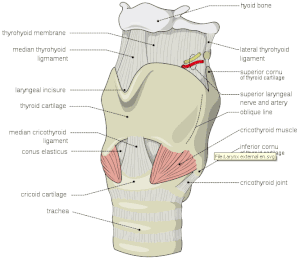 | |
| In cricothyrotomy, the incision or puncture is made through the cricothyroid membrane, between the thyroid and cricoid cartilage. Should be horizontal rather than vertical. | |
| Specialty | Emergency medicine |
| Indications | Cannot intubate and cannot ventilate[1] |
| Contraindications | Less than 6 to 8 years old[1][2] |
| Steps | 1) Locate the cricothyroid membrane (CTM) 2) Make a 4 cm vertical cut in the skin 3) Make a horizontal cut through the CTM 4) Place a finger than bougie through the hole 5) Pass a 6.0 ET tube over the bougie[3] |
| Success | End-tidal CO2, bilateral chest rise[3][4] |
| Complications | Bleeding, infection, fistula formation[4] |
| Alternatives | Jet ventilation[5] |
Cricothyrotomy is a cut through the skin and cricothyroid membrane to establish an airway when other means of ventilating a person, such as intubation and bag valve mask fail.[3] This may include in the setting of excessive bleeding within the mouth or facial trauma.[3]
While the procedure can be done in a number of ways, a common technique is the "scalpel-finger-bougie".[3] The first step is locating the cricothyroid membrane (CTM) between the thyroid and cricoid cartilage.[3] A 4 cm vertical cut is made through the skin.[3] A horizontal cut is made through the CTM.[3] A finger and then a bougie is placed in the hole.[3] A 6.0 ET tube is then placed over the bougie until the cuff just disappears at which point it is inflated.[3] In children a 4.0 ET tube may be used.[6]
Signs of success include end-tidal CO2 and chest rise on both sides.[3][4] The ET tube is than secured in place.[3] In those at high risk, set up for a cricothyrotomy may be done before starting intubation.[4] The procedure is not recommended in those under the age of 5 to 12 years, though jet ventilation may be done in younger people.[1][2][5] Cricothyrotomy is easier to perform than a tracheotomy, though this procedure may be performed at a later date.[3][1]
Use has become less common due to other improvements in airway management.[1] In the emergency room, they are carried out in less than 3 in 1,000 intubations, with most being done due to trauma.[7] The procedure was first formally carried out in 1909, though did not come into common use until the 1970s.[3] The average time to perform the procedure is just over a minute.[4]
Medical uses
A cricothyrotomy is often used as an airway of last resort given the numerous other airway options available including standard tracheal intubation and rapid sequence induction which are the common means of establishing an airway.[8] Cricothyrotomies account for approximately 1% of all emergency department intubations, and is used mostly in persons who have experienced a traumatic injury.[8]
Some general indications for this procedure include:[8]
- Can not intubate
- Can not ventilate
- Can not maintain SpO2 >90%
- Severe traumatic injury that prevents tracheal intubation
Rarely it may be done before attempting to intubate in an awake person, when intubation is deemed to be likely impossible.[9]
Contraindications
There are no absolute contraindications.[3] Relative contraindications include:
Technique
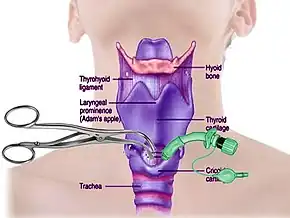
Sedation such as with 20 mg of intravenous ketamine may be used if required and time permits.[4] The person is placed on their back and if a roll can be placed between the shoulders it may make the procedure easier.
Scalpel-finger-bougie
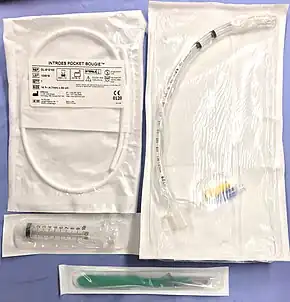
- The first step is to feel the laryngeal prominence (Adam's apple) or the thyroid cartilage.[3] Moving 2 centimeters lower on the neck in a depression representing the cricothyroid membrane (CTM) after which is the cricoid cartilage.[3]
- Make a 4 centimeter vertical cut through the skin over the CTM[3]
- Bluntly dissection with fingers down to the CTM[3]
- Cut with the scalpel horizontally through the CTM and place your finger through the hole[3]
- Pass the bougie through the hole guiding it inferiorly[3]
- Pass a 6.0 or 6.5 cuffed endotracheal tube over the bougie[3][10]
- Bag valve mask with end tidal CO2 attached[3]
A longer vertical cut may be made if locating the CTM is difficult.[4] This may include cutting from the upper to the lower part of the neck and pulling tissue apart with your hands in those who are very obese. The average time to perform the procedure is just over a minute.[4]
Guidewire cricothyrotomy
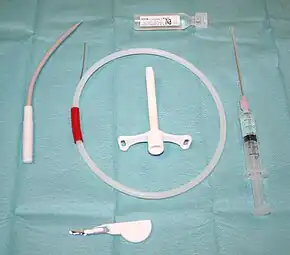
A needle cricothyrotomy is similar, but instead of making a scalpel incision, a large over-the-needle catheter is inserted (10- to 14-gauge). Air is aspirated and a wire is placed through the needle. A dilator and tube is than placed over the wire. There are specially designed kits with this equipment.
If the dilator and tube is not used the technique provides very limited airflow. The delivery of oxygen to the lungs through an over-the-needle catheter using a high pressure gas source is considered a form of ventilation called percutaneous transtracheal ventilation (PTV).
Post-procedure
Signs of success include end-tidal CO2 and chest rise on both sides.[3][4] The ET tube is than secured in place.[3] A chest X-ray is than done to confirm placement.[2]
Complications
Complications occur in about 10 to 40% of cases.[5] These most commonly are a tube going in the wrong spot or bleeding.[5] Other complications may include subcutaneous emphysema, pneumothorax, pneumomediastinum, blockage of the tube, vocal cord injury and laryngeal cartilages injury.[5]
History
The procedure was first formally carried out in 1909 by Chevalier Jackson though did not come into common use until the 1970s.[3]
Society and culture
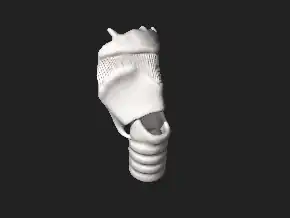
On the TV show M*A*S*H,[11] Father Mulcahy performs an emergency cricothyrotomy on a person. With the direction of Dr. Pierce via radio, he uses a pen, knife and an eyedropper to perform the operation. Needless to say, this would be extremely dangerous in real life. Even under ideal, clinical conditions, a cricothyrotomy is difficult and requires specific tools, preparation and a practiced knowledge of anatomy. There are many major blood vessels and nerves in the neck and cutting there carries a high risk of harming the person.
In the 1980 Nicolas Roeg film Bad Timing, Theresa Russell's character Milena Flaherty has an emergency cricothyrotomy performed following an intentional overdose.
In Grey's Anatomy, emergency cricothyrotomy is mentioned in at least three episodes:
- In "Owner of a Lonely Heart," Cristina almost performs an emergency cricothyrotomy on a patient who swallowed a light bulb. Before she is able to do so, however, Dr. Burke shows up and takes the patient to an operating room where he proceeds to perform an emergency thoracotomy.
- In "The Heart of the Matter," Izzie performs her first emergency crike on Camille, a niece of Chief of Surgery Dr. Richard Webber.
- In "I Saw What I Saw" Alex performs a crike on the patient who later dies.
In the ER episode "Reason to Believe" Dr. Kerry Weaver performs an emergency cricothyrotomy on a student. She is shooting a news segment on childhood obesity in an elementary school cafeteria when one of the students begins to choke; after the heimlich maneuver fails, she performs a cricothyrotomy with a kitchen knife and a drinking straw.
In the film Playing God (1997), David Duchovny plays a famed LA surgeon, stripped of his license due to drug abuse, who finds himself witnessing a gunfight at a bar. He saves a mafia crime figure by performing an emergency cricothyrotomy. This endears him with the mafia family and drives the plot forward.
In the BBC3 medical drama Bodies, the main protagonist Rob Lake, a newly appointed obstetrics and gynaecology registrar (played by Max Beesley), is called to a patient who is having difficulty breathing due to epiglottitis. Lake calls for emergency assistance but help is slow coming, so fearing for the patient's life decides to undertake a cricothyrotomy himself - a procedure he has not been trained in. The procedure is unsuccessful and the patient dies before help arrives. The guilt surrounding the event combined with the covering up by his consultant provides an important backdrop to the further development of the character and his relationship with his consultant.
In Dr. Quinn, Medicine Woman, Sully, the white man raised by Native Americans who is her lover and companion, performs the procedure on one of Dr. Quinn's boys using a bird's feather (the base where it is hollow).
During an episode of the National Geographic Channel documentary "Inside Combat Rescue",[12] a US Air Force Pararescueman in Afghanistan performs an actual cricothyrotomy on a wounded civilian, in a helicopter maneuvering under combat conditions. The procedure is successful and the patient is delivered to Kandahar Regional Medical Hospital.
On the New Zealand soap opera Shortland Street, Series 21, Episode 5104/5105, student doctor Paige Munroe performs a cricothyrotomy with a pocket knife and pen and saves a woman's life, even though she was not qualified (and nervous).
In the novel Night Train to Lisbon by Swiss author Pascal Mercier, one of the protagonists saves the life of his asphyxiating sister by performing a provisional cricothyrotomy with a ballpoint pen.
In the 1997 film Anaconda, when the character Dr. Steven Cale (Eric Stoltz) is stung in the mouth by a poisonous wasp found in his scuba equipment, Paul Serone (Jon Voight) performs the procedure using a pocket knife and rigid plastic tube.
See also
- Laryngotomy
- List of surgeries by type
References
- 1 2 3 4 5 M. Gregory Katos; David Goldenberg (June 2007). "Emergency cricothyrotomy". Operative Techniques in Otolaryngology. 18 (2): 110–114. doi:10.1016/j.otot.2007.05.002. Archived from the original on 28 August 2021. Retrieved 25 July 2010.
- 1 2 3 "How To Do a Percutaneous Cricothyrotomy - Critical Care Medicine". Merck Manuals Professional Edition. Archived from the original on 17 January 2021. Retrieved 18 March 2021.
- 1 2 3 4 5 6 7 8 9 10 11 12 13 14 15 16 17 18 19 20 21 22 23 24 25 26 27 28 29 McKenna, P; Desai, NM; Morley, EJ (January 2021). "Cricothyrotomy". PMID 30726035.
{{cite journal}}: Cite journal requires|journal=(help) - 1 2 3 4 5 6 7 8 9 "Surgical Cricothyroidotomy • LITFL Medical Blog • CCC Airway". Life in the Fast Lane • LITFL. 1 January 2019. Archived from the original on 10 April 2021. Retrieved 18 March 2021.
- 1 2 3 4 5 Mace SE, Khan N (2008). "Needle cricothyrotomy". Emerg Med Clin North Am. 26 (4): 1085–101, xi. doi:10.1016/j.emc.2008.09.004. PMID 19059102. Archived from the original on 2021-08-28. Retrieved 2022-03-14.
- ↑ Berger-Estilita, J; Wenzel, V; Luedi, MM; Riva, T (6 April 2021). "A Primer for Pediatric Emergency Front-of-the-Neck Access". A&A practice. 15 (4): e01444. doi:10.1213/XAA.0000000000001444. PMID 33821828.
- ↑ Offenbacher, J; Nikolla, DA; Carlson, JN; Smith, SW; Genes, N; Boatright, DH; Brown CA, 3rd (June 2023). "Incidence of rescue surgical airways after attempted orotracheal intubation in the emergency department: A National Emergency Airway Registry (NEAR) Study". The American journal of emergency medicine. 68: 22–27. doi:10.1016/j.ajem.2023.02.020. PMID 36905882.
- 1 2 3 A., Marx, John; S., Hockberger, Robert; M., Walls, Ron; H., Biros, Michelle; F., Danzl, Daniel; Marianne, Gausche-Hill; Andy, Jagoda; 1954-, Ling, Louis; 1950-, Newton, Edward (2014). Rosen's emergency medicine : concepts and clinical practice. pp. 15–22. ISBN 9781455706051. OCLC 853286850.
{{cite book}}: CS1 maint: numeric names: authors list (link) - ↑ Weingart, Scott; FCCMEditor-in-Chief, M. D.; interest, at EMCrit orgAn ED Intensivist from NY ProfessorNassau University Medical CenterNo conflicts of (26 August 2014). "EMCrit Podcast 131 - Cricothyrotomy - Cut to Air: Emergency Surgical Airway". EMCrit Project. Archived from the original on 21 January 2022. Retrieved 20 June 2022.
- ↑ Dharamsi, Alia. "Steps to performing a ScalpelFinger-Bougie (SFB) Cric" (PDF). web.archive.org. Archived from the original on 21 January 2021. Retrieved 16 October 2023.
{{cite web}}: CS1 maint: bot: original URL status unknown (link) - ↑ M*A*S*H 5x08 "Mulcahy's War", archived from the original on 2019-12-11, retrieved 2019-11-20
- ↑ "Combat cricothyrotomy inflight -Inside Combat Rescue series | PHARM". Archived from the original on 2014-04-22. Retrieved 2014-04-21.
External links
- One page overview
- EMRAP: Cricothyroidotomy Archived 2021-08-28 at the Wayback Machine
- Life in the Fastlane: Cricothyroidotomy Archived 2021-04-10 at the Wayback Machine
- emDocs: Cricothyroidotomy Archived 2021-01-18 at the Wayback Machine
- 3D model for SIMs Archived 2021-01-17 at the Wayback Machine
| Classification | |
|---|---|
| External resources |